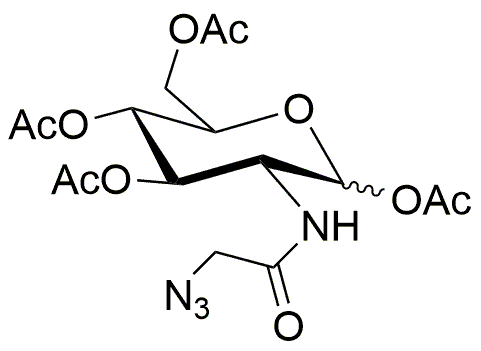N-azidoacetylglucosamine-tetraacylated (Ac4GlcNAz) is widely utilized in research focused on:
- Bioconjugation: This compound serves as a versatile building block for attaching biomolecules, such as proteins and nucleic acids, to surfaces or other molecules, enhancing the development of targeted drug delivery systems.
- Glycobiology Studies: Researchers use Ac4GlcNAz to investigate glycan structures and their biological roles, aiding in the understanding of cell signaling and interactions in various diseases.
- Drug Development: Its unique azide functional group allows for click chemistry applications, facilitating the synthesis of novel therapeutics with improved efficacy and specificity.
- Diagnostics: The compound can be incorporated into diagnostic assays, improving the detection of biomolecules in clinical samples, which is crucial for early disease diagnosis.
- Material Science: Ac4GlcNAz is utilized in the creation of functionalized surfaces and materials, enhancing their properties for applications in biomedical devices and tissue engineering.
General Information
Properties
Safety and Regulations
Applications
N-azidoacetylglucosamine-tetraacylated (Ac4GlcNAz) is widely utilized in research focused on:
- Bioconjugation: This compound serves as a versatile building block for attaching biomolecules, such as proteins and nucleic acids, to surfaces or other molecules, enhancing the development of targeted drug delivery systems.
- Glycobiology Studies: Researchers use Ac4GlcNAz to investigate glycan structures and their biological roles, aiding in the understanding of cell signaling and interactions in various diseases.
- Drug Development: Its unique azide functional group allows for click chemistry applications, facilitating the synthesis of novel therapeutics with improved efficacy and specificity.
- Diagnostics: The compound can be incorporated into diagnostic assays, improving the detection of biomolecules in clinical samples, which is crucial for early disease diagnosis.
- Material Science: Ac4GlcNAz is utilized in the creation of functionalized surfaces and materials, enhancing their properties for applications in biomedical devices and tissue engineering.
Documents
Safety Data Sheets (SDS)
The SDS provides comprehensive safety information on handling, storage, and disposal of the product.
Product Specification (PS)
The PS provides a comprehensive breakdown of the product’s properties, including chemical composition, physical state, purity, and storage requirements. It also details acceptable quality ranges and the product's intended applications.
Certificates of Analysis (COA)
Search for Certificates of Analysis (COA) by entering the products Lot Number. Lot and Batch Numbers can be found on a product’s label following the words ‘Lot’ or ‘Batch’.
Numéro de catalogue
Numéro de lot/série
Certificates Of Origin (COO)
This COO confirms the country where the product was manufactured, and also details the materials and components used in it and whether it is derived from natural, synthetic, or other specific sources. This certificate may be required for customs, trade, and regulatory compliance.
Numéro de catalogue
Numéro de lot/série
Safety Data Sheets (SDS)
The SDS provides comprehensive safety information on handling, storage, and disposal of the product.
DownloadProduct Specification (PS)
The PS provides a comprehensive breakdown of the product’s properties, including chemical composition, physical state, purity, and storage requirements. It also details acceptable quality ranges and the product's intended applications.
DownloadCertificates of Analysis (COA)
Search for Certificates of Analysis (COA) by entering the products Lot Number. Lot and Batch Numbers can be found on a product’s label following the words ‘Lot’ or ‘Batch’.
Numéro de catalogue
Numéro de lot/série
Certificates Of Origin (COO)
This COO confirms the country where the product was manufactured, and also details the materials and components used in it and whether it is derived from natural, synthetic, or other specific sources. This certificate may be required for customs, trade, and regulatory compliance.


